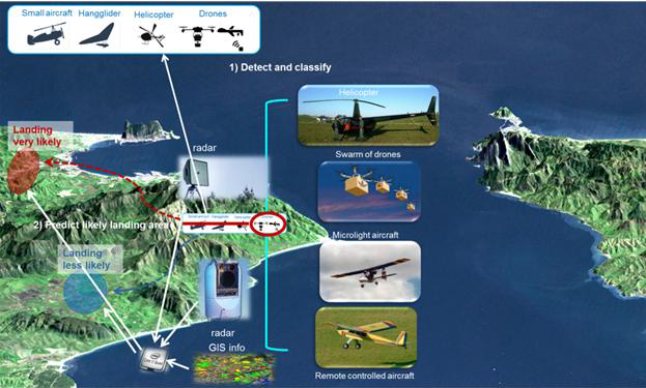| Stay up to date with project news, upcoming events and results | Subscribe to Newsletter |
Summary of the project results
Context and overall objectives of the project ALFA provides a solution for the detection of small aircraft that are used to smuggle drugs from Morocco to Spain and Portugal. The system will assist the police officers to hunt down and arrest the smugglers.
Protecting European borders against drug trafficking is vitally important. More and more, small aircraft are used that can cross the sea border (almost) undetected due to their small size and low flight altitude. A hot-spot in this respect is the Strait of Gibraltar where many cases of airborne drugs smuggling are reported. Drones are already widespread used at the US-Mexican border. It is just a matter of time until drones are used in Europe too. Drones also can be launched from vessels close to the coast.
Efficient pursuit of drug trafficking requires timely warning and knowledge of the intended landing site or dropping zone. This will allow law enforcement entities to intercept the drugs and smugglers on the ground, as well as the pilot in case of landing.
Timely warning cannot always be obtained from existing coastal surveillance systems. Aircraft are small and often low-flying, which makes them hardly visible. Trafficking aircraft typically fly at very low altitudes to avoid showing up on radar during night-time hours or at dawn. Existing radar systems are mainly designed for surface surveillance, in other words for detecting and tracking vessels of all kinds. A system is needed that can add the capability to detect small low flying aircraft and drones. To be able to hunt down and arrest smugglers on the ground, a prediction of the landing or dropping zone is needed.
The ALFA project is developing a system that can cope with the above mentioned situation. The ALFA system consists of radars, cameras and other sensors that are specifically designed to detect small aircraft and drones. Moreover, the system can reveal much information about the craft, like for example the rotational speed of the engine and, for a drone, the number of rotors. This all helps the identification of the drone or aircraft.

The following ground breaking objectives are paramount for ALFA:
- New radar technologies.
- Advanced processing technologies.
- Future sensor technologies
- Advanced architectural design
Work performed throughout the project lifetime
The work performed in the considered period:
- An extensive study has been performed to reveal the type of aircraft that could fulfil the smugglers needs.
- GC and GNR have provided a good view on the operational aspects of the combatting of drug trafficking and the related requirements on situational awareness
- The architecture design has been detailed, including sensors and processing, information flow and data model, and provisions for connection with other systems (SIVE, SIVICC)
- Radar technology has been developed to detect small aircraft in a sea clutter environment. The development of specific microDoppler technology for ALFA allows for the extraction of various attributes of the drone or aircraft.
- Camera software was developed to perform azimuth, elevation and size measurements of a dedicated target.
- Software has been developed for data fusion, detection, classification, tracking, feature extraction, behavioral analysis, threat analysis and landing site prediction.
- Various tests have been performed, including live tests using real aircraft. Those tests helped to verify operation of both hardware and software, in addition they provided data to train and optimize the detection and classification algorithms.
- All activities culminated in a successful final demonstration.
Progress beyond the state of the art and results
Progress beyond state-of-the-art and expected results: ALFA has taken detection and tracking of low flying, small and/or slow aircraft to a new level. Sensor performance, fusion and processing was brought to a level that enables superb detection and tracking of targets while providing a good prediction of the most probable landing sites. ALFA has combined four essential steps to resolve this:- Apply highly innovative fusion techniques, to achieve detection and tracking performance that is unachievable for single sensors.
- Apply highly innovative classification techniques, essential to separate targets from all clutter which will also be detected due to lower detection thresholds needed to detect smaller and slower targets.
- Apply highly sensitive sensors capable to detect also the smaller and slower air targets. We have improved radar by adding new technologies like micro-Doppler (aiming at high TRL) and added passive radar and passive RF.
- Inclusion of any available information source. The concepts of open architecture and common data model are now exploited up to the level needed in ALFA, with respect to data rate, heterogeneous data types and application.
Impacts:
- ALFA will contribute to development and enhancement of the existing EU surveillance system EUROSUR and prevent cross border crimes:
- ALFA detection capability of UAV will be adaptable in other scenarios, not only in the border surveillance, e.g. protection of sensitive infrastructure
- ALFA will improve the situational awareness thanks to a continuous detection of targets currently undetectable by many of existing surveillance systems
- ALFA will improve the reaction capability and decision making thanks to the early menace detection, to the potential landing sites identification and to the use of tools that are easily deployable and able to increase the surveillance capabilities
- ALFA will have positive impacts on user operational procedures and will help in cost reduction, automating surveillance tasks, currently done by using specific resources (helicopters, land patrol and people), that could be employed in other services

